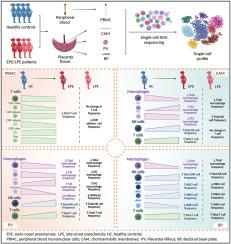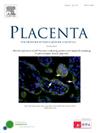单细胞RNA测序揭示子痫前期的全身和胎盘免疫景观
IF 2.5
2区 医学
Q2 DEVELOPMENTAL BIOLOGY
引用次数: 0
摘要
背景子痫前期(PE)是妊娠最严重的并发症之一,以全身和胎盘炎症为特征。最近,研究已经在单细胞水平上描述了子痫前期的免疫景观,需要进一步研究以了解胎盘室和疾病亚型之间的空间差异。方法采用单细胞RNA测序技术对早、晚发性PE (EPE/LPE)及正常对照组外周血和胎盘室免疫细胞进行分析。结果我们的数据显示免疫细胞组成和比例在外周血和不同胎盘室之间存在显著差异。此外,我们发现与血压正常的对照组相比,PE患者表现出不同的免疫细胞分布和基因表达谱。此外,EPE和LPE患者免疫细胞的频率和功能状态存在差异。当对主要免疫细胞进行亚簇时,我们发现PE患者外周血中调节性T细胞减少。EPE妊娠胎盘绒毛中几乎没有霍夫鲍尔细胞。此外,我们在外周血中发现了一种新的CD8+ naïve T细胞亚群,只存在于EPE中,在基底中发现了一种新的dNK4细胞亚群,在EPE中显著减少。我们的研究提供了外周血和胎盘室的全面单细胞免疫图谱,强化了PE妊娠中观察到的促炎环境。此外,我们的分析显示EPE和LPE之间存在明显的免疫学差异。这些发现为这些妊娠障碍的早期预测和治疗干预提供了潜在的见解。本文章由计算机程序翻译,如有差异,请以英文原文为准。

Single-cell RNA sequencing reveals systemic and placental immune landscape in preeclampsia
Background
Preeclampsia (PE) is one of the most severe complications of pregnancy characterized by systemic and placental inflammation. Recently, studies have characterized the immune landscape in preeclampsia at single-cell level, further investigation is needed to understand spatial differences across placental compartments and disease subtypes.
Methods
We utilized single-cell RNA sequencing to profile the immune cells of peripheral blood and placenta compartments from early- and late-onset PE (EPE/LPE), as well as normotensive controls.
Results
Our data revealed significant differences in immune cell composition and proportions across peripheral blood and various placenta compartments. Additionally, we found that PE patients exhibited distinct immune cell distributions and gene expression profiles compared to normotensive controls. Moreover, the frequencies and functional states of immunocytes varied between EPE and LPE patients. When subclustered major immune cells, we discovered a reduction of regulatory T cells in peripheral blood of PE patients. Hofbauer cells were almost absent in placental villi of EPE pregnancies. Furthermore, we identified a novel subset of CD8+ naïve T cells in peripheral blood, exclusively present in EPE, and a new subset of dNK4 cells in basal plate, which were significantly decreased in EPE.
Conclusions
Our study offers a comprehensive single-cell immune profile of peripheral blood and placental compartments, reinforcing the heightened pro-inflammatory environment observed in PE pregnancies. Furthermore, our analysis reveals distinct immunological differences between EPE and LPE. These findings provide potential insights for early prediction and therapeutic interventions in these disordered pregnancies.
求助全文
通过发布文献求助,成功后即可免费获取论文全文。
去求助
来源期刊

Placenta
医学-发育生物学
CiteScore
6.30
自引率
10.50%
发文量
391
审稿时长
78 days
期刊介绍:
Placenta publishes high-quality original articles and invited topical reviews on all aspects of human and animal placentation, and the interactions between the mother, the placenta and fetal development. Topics covered include evolution, development, genetics and epigenetics, stem cells, metabolism, transport, immunology, pathology, pharmacology, cell and molecular biology, and developmental programming. The Editors welcome studies on implantation and the endometrium, comparative placentation, the uterine and umbilical circulations, the relationship between fetal and placental development, clinical aspects of altered placental development or function, the placental membranes, the influence of paternal factors on placental development or function, and the assessment of biomarkers of placental disorders.
 求助内容:
求助内容: 应助结果提醒方式:
应助结果提醒方式:


